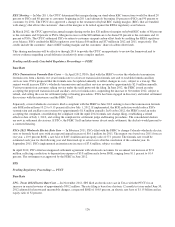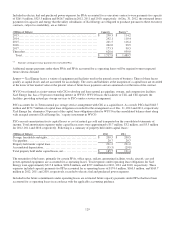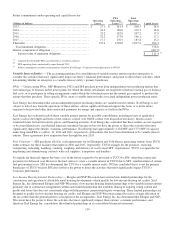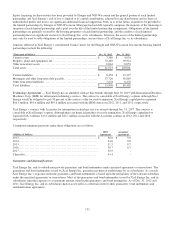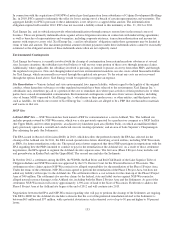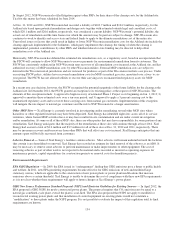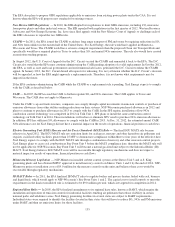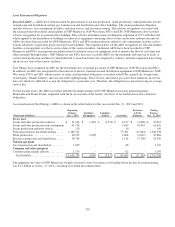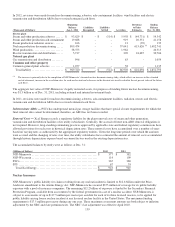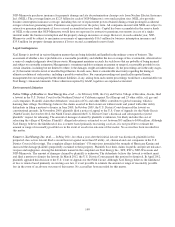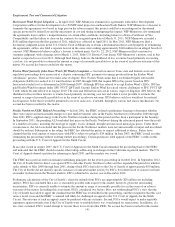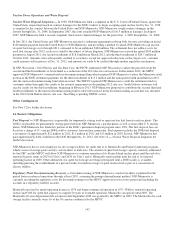Xcel Energy 2012 Annual Report Download - page 144
Download and view the complete annual report
Please find page 144 of the 2012 Xcel Energy annual report below. You can navigate through the pages in the report by either clicking on the pages listed below, or by using the keyword search tool below to find specific information within the annual report.134
In August 2012, NSP-Wisconsin also filed litigation against other PRPs for their share of the cleanup costs for the Ashland site.
Trial for this matter has been scheduled for June 2014.
At Dec. 31, 2012 and 2011, NSP-Wisconsin had recorded a liability of $103.7 million and $104.3 million, respectively, for the
Ashland site based upon potential remediation and design costs together with estimated outside legal and consultant costs; of
which $20.1 million and $26.6 million, respectively, was considered a current liability. NSP-Wisconsin’s potential liability, the
actual cost of remediation and the time frame over which the amounts may be paid are subject to change. NSP-Wisconsin also
continues to work to identify and access state and federal funds to apply to the ultimate remediation cost of the entire site.
Unresolved issues or factors that could result in higher or lower NSP-Wisconsin remediation costs for the Ashland site include the
cleanup approach implemented for the Sediments, which party implements the cleanup, the timing of when the cleanup is
implemented, potential contributions by other PRPs and whether federal or state funding may be directed to help offset
remediation costs at the Ashland site.
Historically, NSP-Wisconsin has deferred the estimated site remediation costs, as a regulatory asset, based on an expectation that
the PSCW will continue to allow NSP-Wisconsin to recover payments for environmental remediation from its customers. The
PSCW has consistently authorized in NSP-Wisconsin rates recovery of all remediation costs incurred at the Ashland site, and has
authorized recovery of MGP remediation costs by other Wisconsin utilities. External MGP remediation costs are subject to
deferral in the Wisconsin retail jurisdiction and are reviewed for prudence as part of the Wisconsin retail rate case process. Under
an existing PSCW policy, utilities have recovered remediation costs for MGPs in natural gas rates, amortized over a four- to six-
year period. The PSCW has not allowed utilities to recover their carrying costs on unamortized regulatory assets for MGP
remediation.
In a recent rate case decision, however, the PSCW recognized the potential magnitude of the future liability for the cleanup at the
Ashland site. In December 2012, the PSCW granted an exception to its existing policy at the request of NSP-Wisconsin. The
elements of this exception include: 1) approval to begin recovery of estimated Phase 1 Project costs beginning on Jan. 1, 2013; 2)
approval to amortize these estimated costs over a ten-year period; and 3) approval to apply a 3 percent carrying cost to the
unamortized regulatory asset and to recover these carrying costs from natural gas customers. Implementation of this exception
will mitigate the rate impact to natural gas customers and the risk to NSP-Wisconsin for a longer amortization.
Other MGP Sites — Xcel Energy is currently involved in investigating and/or remediating several other MGP sites where
hazardous or other regulated materials may have been deposited. Xcel Energy has identified eight sites across all of its service
territories, where former MGP activities have or may have resulted in site contamination and are under current investigation
and/or remediation. At some or all of these MGP sites, there are other parties that may have responsibility for some portion of any
remediation. Xcel Energy anticipates that the majority of the remediation at these sites will continue through at least 2014. Xcel
Energy had accrued a total of $3.0 million and $3.9 million for all of these sites at Dec. 31, 2012 and 2011, respectively. There
may be insurance recovery and/or recovery from other PRPs that will offset any costs incurred. Xcel Energy anticipates that any
amounts spent will be fully recovered from customers.
Asbestos Removal — Some of Xcel Energy’s facilities contain asbestos. Most asbestos will remain undisturbed until the facilities
that contain it are demolished or removed. Xcel Energy has recorded an estimate for final removal of the asbestos as an ARO. It
may be necessary to remove some asbestos to perform maintenance or make improvements to other equipment. The cost of
removing asbestos as part of other work is not expected to be material and is recorded as incurred as operating expenses for
maintenance projects, capital expenditures for construction projects or removal costs for demolition projects.
Environmental Requirements
EPA GHG Regulation — In 2009, the EPA issued its “endangerment” finding that GHG emissions pose a threat to public health
and welfare. In 2011, new EPA permitting requirements became effective for GHG emissions of new and modified large
stationary sources, which are applicable to the construction of new power plants or power plant modifications that increase
emissions above a certain threshold. Xcel Energy is unable to determine the cost of compliance with these new EPA requirements
as it is not clear whether these requirements will apply to future changes at Xcel Energy’s power plants.
GHG New Source Performance Standard Proposal (NSPS) and Emission Guideline for Existing Sources — In April 2012, the
EPA proposed a GHG NSPS for newly constructed power plants. The proposal requires that CO2 emission rates be equal to a
natural gas combined-cycle plant, even if the plant is coal-fired. The EPA also proposed that NSPS not apply to modified or
reconstructed existing power plants and that installation of control equipment on existing plants would not constitute a
“modification” to those plants under the NSPS program. It is not possible to evaluate the impact of this regulation until its final
requirements are known.




